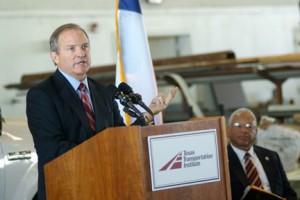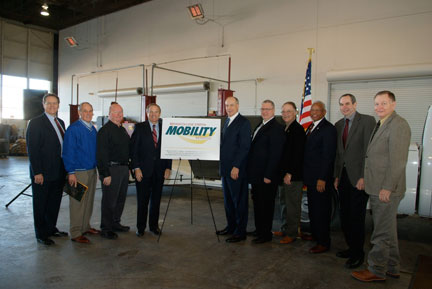
Rep. Chet Edwards detailed the “Bryan/College Station Mobility Initiative” — a unique agreement designed to improve the quality of transportation in smaller communities — during a news conference at the Texas Transportation Institute (TTI) on January 30.
Edwards secured $1 million in funding for the initiative, which will house a traffic management system at TTI’s TransLink® Laboratory, in partnership with the cities of Bryan and College Station, Brazos County, Texas A&M University, the local Texas Department of Transportation district, the Bryan/College Station Metropolitan Planning Organization and TTI.
“This [Bryan/College Station Mobility Initiative] is about growth, it’s about quality of life for our families, it’s about air quality and it’s about safety,” Edwards said. “Improving roads and easing congestion are vital to Bryan/College Station.”
The population of Brazos County has nearly doubled in the last 30 years to 170,000 residents. In addition, Texas A&M has experienced almost a 60 percent increase in visitors over the last 10 years. Annual visitors to the Bryan/College Station community total about 3.7 million each year.
“If we are not visionary, we will be like Austin in the near future,”” said College Station Mayor Ben White, who grew up in the Austin area and knows how quickly congestion can become a major problem.
The TransLink® Laboratory at TTI will be used to monitor traffic with cameras set up in key locations in the community. It will also help with the coordination of traffic signals, data collection and special events planning. Area traffic is especially congested during the numerous Texas A&M sporting events throughout the year.
“We have the equivalent of a big-city traffic operations system here at TTI,” Agency Director Dennis Christiansen told members of the news media and local dignitaries attending the event. “Although it will not take the place of new road construction, the system will help increase capacity on area roadways by up to 20 percent.”
Edwards told the crowd that the cooperation among the entities that make up the Bryan/College Station Mobility Initiative could become a model for other small city regional transportation planning efforts.
Following the news conference, Edwards, along with members of the news media, attended a crash test that was held on TTI’s Proving Grounds located at the Riverside Campus. He witnessed a pickup truck crashing into a concrete barrier at 62 miles per hour. “This was my first crash test,” Edwards said. “It’s amazing the work that the researchers are doing for the safety of our motorists. TTI is truly an American treasure.”

